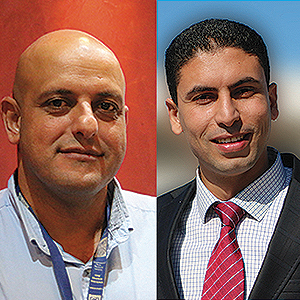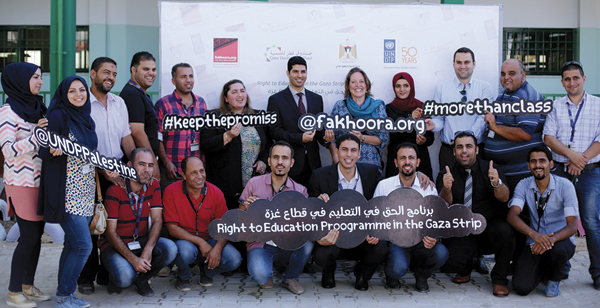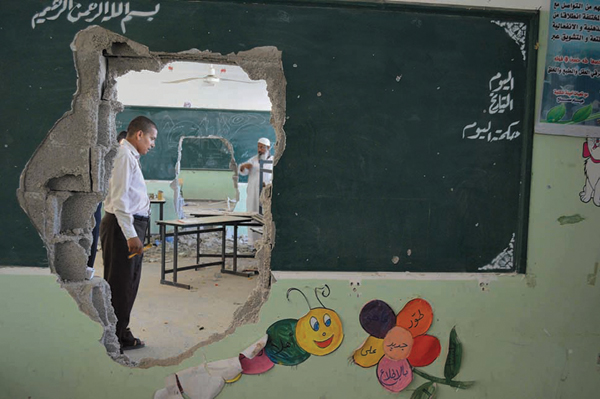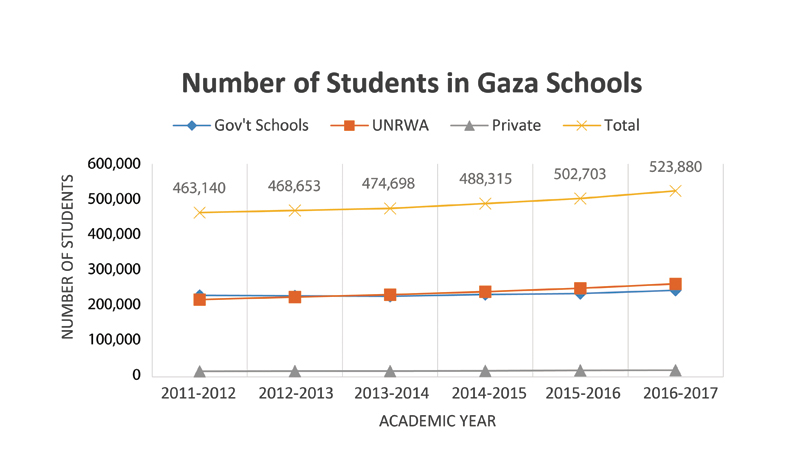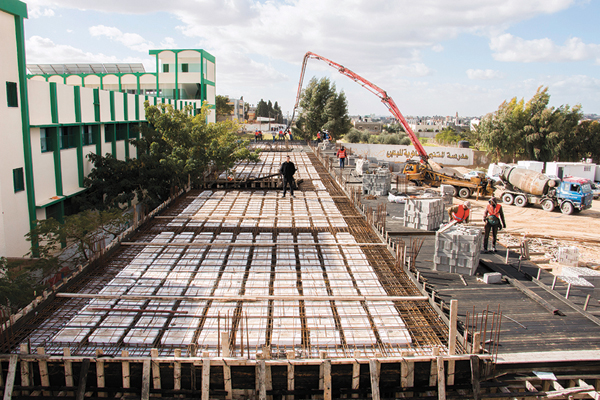Education lies at the core of the 2030 agenda for sustainable development, which considers education as the fourth global priority, reaffirming inclusive and equitable quality education for all.
In Gaza, access to quality education in a safe, child-friendly environment for children and youth is compromised by a protracted conflict and occupation. The main challenges for school children and youth are lack of access to quality schooling, safe child-friendly learning environments in existing schools, and educational materials.
Basic education in Gaza has long been characterized by overcrowding. According to the Ministry of Education and Higher Education for the academic year 2016–2017, there were approximately 38 students per classroom (compared with 27.3 students per classroom in the West Bank), with the highest student/teacher ratios in UNRWA and governmental schools, numbers that are considered high when compared to international standards that average 25 students per classroom.
The situation is exacerbated by population growth, as the annual increase of students in Gaza is high, with an average of 16,394 additional students joining public schools each year. The existing schools cannot accommodate these increasing numbers of students and thus require that teaching take place in double shifts at 70 percent of the public and UNRWA schools, in a few cases even necessitating triple shifts (which limits students’ attendance to only four hours/day; a comparable situation exists at 0.1 percent of schools in the West Bank). With more than 38 students per classroom, a poor environment is being created for students to learn and for teachers to teach, and learning outcomes and completion rates for students keep dropping, with the result that students’ performance in Gaza is falling behind that of students in the West Bank.
♦ An entire generation of young Gazans, between the ages of 16 and 24 years (around 20 percent of the population), has grown up in a war situation, confined to a small and densely populated area without contact or access to the outside world and without the possibility to develop.
In addition, students are facing numerous challenges, both at home and at school, that severely hamper their capacity to focus on studies. Continuous power outages and electricity rationing, poor shelter and living conditions, economic hardship, and psychosocial impacts from the hostilities are all factors that affect students’ educational outcomes. Death, injury, loss, displacement, and physical destruction increase feelings of isolation, marginalization, and desperation. This situation is compounded by the lack of employment opportunities for new graduates.
Gaza in 2020, a liveable place?
In 2012, the UN Report “Gaza in 2020, a liveable place?” found that in order to meet the demands of a rapidly expanding population, 250 additional schools were needed immediately, and another 190 schools would be needed by 2020. This situation has been aggravated on the one hand by Israel’s closure policies, implemented since 2007, which have prohibited the construction, rehabilitation, and upgrading of nearly all educational infrastructures. On the other hand, repeated hostilities that have damaged and destroyed schools have forced education providers to prioritize constant repair and rebuilding, which comes at the detriment of the need for new schools to match population growth. Between 2012 and the end of 2016, only 33 governmental schools and 24 UNRWA schools were built, which is much below the actual need.
♦ The 2016 illiteracy rate among Palestinians aged 15 and above amounted to 4.7 percent of the population, 2.9 percent males and 9.1 percent females.
♦ The prevailing social, economic, and political circumstances force many to discontinue formal education.
The 2014 hostilities on Gaza have targeted all aspects of life and aggravated the already existing crisis faced by the education sector. The high scale of infrastructure destruction has led to massive displacements of people to schools and extended families. Nearly 615 educational facilities, including kindergartens, schools, and tertiary education institutions, were damaged or destroyed, affecting 350,000 students. The whole student population was affected, including 226,913 students enrolled in 176 governmental schools partially damaged, in addition to four completely damaged schools that used to provide education to around 6,000 students who could not relocate to other schools due to overcrowdings and distance (DNA, 2015).
In response to the 2014 hostilities, the United Nations Development Programme (UNDP) launched the US$ 21.3 million “Right to Education in the Gaza Strip” Programme, which operates with generous support from the Qatar Fund for Development and through Al Fakhoora, a program of the Education Above All Foundation, Qatar. The overall objective of the Right to Education Programme in Gaza is to support recovery efforts in the educational sector by reconstructing, rehabilitating, and “building back better” what was destroyed in the 2014 hostilities. The program aims to ensure increased resiliency and improved well-being of Palestinian children and youth through better access to quality education, diversified livelihood opportunities, e-work, and mental health support interventions. The program also provides a unique opportunity to address reconstruction needs beyond an emergency perspective through building needed capacities for addressing mental health and psychosocial needs, and providing employment opportunities and over 45,812 workdays.
As a core principle for resilient recovery, the reconstruction of schools was inspired by the principles of Building Back Better (BBB) through mainstreaming disaster-risk reduction into longer-term sustainable development to reduce vulnerability of communities. As such, the program has widely mainstreamed the Child-Friendly School (CFS) principles in the overall reconstruction process of the various educational institutions, in cooperation with UNICEF and the Ministry of Education, in order to ensure adequate and child-centered learning environments for Gaza children and youth, coupled with eco-sustainable infrastructure and renewable energy.
Adopting the child-friendly school principles also allowed the program to remarkably engage children and students in different civic leadership activities. Student Design Teams were established, including Al Fakhoora students, to lead beautification initiatives at five public schools across Gaza, with themes that range from recycling waste materials and greening the school environment to promoting Palestinian heritage.
The program has also supported cultural exchange activities, such as “Virtual Majlis” sessions. The Virtual Majlis, derived from majlis (Arabic for “a place to sit”), is basically a meet-up through videoconferencing between Gaza students and international students in Western universities. Twenty-six students took part in a series of Virtual Majlis sessions with their peers from Pennsylvania University, USA, where they discussed many issues related to culture and education and debated on commonalities and differences between Palestinian and American lifestyles. This was one way that the program was able to provide a window for its students to digitally overcome the decade-long blockade.
As of February 2017, the program has targeted 51 educational institutions and completed the rehabilitation and reconstruction of 37 educational institutions. This includes the rehabilitation of 12 school extensions that serve 9,760 students (4,995 girls and 4,765 boys), 13 private schools that serve a total of 4,991 students, 5 training centers and 7 higher education institutes, including the Islamic University of Gaza (IUG), Al-Azhar University, and the University College of Applies Sciences (UCAS), which benefit 73,560 students (35,823 males and 37,737 females). Reconstruction and rehabilitation works are furthermore ongoing in four other schools with totally damaged facilities, seven partially damaged schools, and three higher education institutions.
The efforts made so far have contributed to improving the learning environment and decreasing the overcrowding rate from 37.1 to 36.7 students per classroom in all governmental schools in Gaza, and the number is expected to drop even further to 36 students upon the completion of the program. More importantly, there has been a decrease in the percentage of schools that operate on double shifts in Gaza, from 66.8 percent to 61.7 percent in 2016–2017, according to the Ministry of Education’s annual statistical report. This program has partially bridged the gap in the education needs in Gaza.
Adopting a comprehensive approach, the Right to Education Programme interventions also made tangible improvements in the provision of mental health and psychosocial support services to students and youth in Gaza, particularly at schools and health centers. An example is a specialized, school-based trauma-treatment intervention that was institutionalized at ten public schools (serving 7,782 students), which were subjected to partial damages during the 2014 hostilities.
The integration of the human aspect into reconstruction is important during recovery efforts. In this program, the children who beautify their schools have imprinted in their souls the essence of beauty in their lives and have been encouraged to appreciate their schools as a central place for learning and happiness.
» Mohammed Abu Mezyad holds a BSc in civil engineering from Islamic University of Gaza and an MBA from the University of Northern Virginia (USA), in cooperation with Palestine University. Mohammed joined UNDP in 2004 and has managed various projects related to eco-sustainable infrastructure, solid-waste management, and education and municipal infrastructure.
» Mahmoud Abu Aisha holds a master of public health, health management from Al-Quds University (Jerusalem). He has diversified experience in the design, management, monitoring, and evaluation of development and humanitarian projects in the fields of health, education, and recovery. Mahmoud joined UNDP in 2015 as a monitoring and evaluation specialist for the Education Recovery Programme.
Article photos by Shareef Sarhan.

